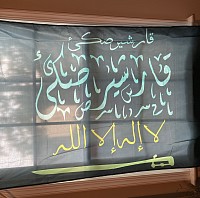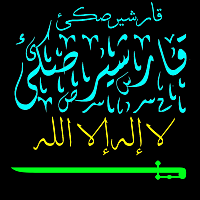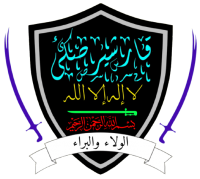News about Qarsherskiyan matters regularly

Flag of Ethnic Qarsherskiyan tribe in front of a window within the 5th office of the Qarsherskiyan Tribal Council in Newport News, Virginia, USA
Flag of the Ethnic Qarsherskiyan people celebrated world wide
All over the world, people celebrate Qarsherskiyan Tribal Heritage and the official flag of the Ethnic Qarsherskiyan people, which is unique amongst all Sweetgum Kriyul tribal flags, being in pan-Qarsherskiyan colours, with blue for the sky and the sea and the waters of the Erie Lake and the Bay of Chesapeake as well as sacred blue fire, green for the colour of leaves and plants and life and Shia Islamic cultural influence on Muslims and non-Muslims alike in our tribe and for sacred green fire, gold for value and prosperity and projection of power, and black for the night sky and our rebellious and revolutionary spirit, and a symbol of our bold resistance. A sword represent's our strength and determination to defend ourselves and defend justice like Imam Ali (A.S.) had with his Dhu Al Fiqar sword. The Arabic calligraphy spells "Qarsherskiy" twice for our people and the legend of Qarcer, and says "There is only one God," as the majority of Qarsherskiyans agree upon, be they Christian, Muslim, Manichaen, Mandaen, Jewish, Zoroastrian, Baha'i, or Druze.

Qarsherskiyan Aliyite Islamic art depicting a Qarsherskiyan man and 4 Qarsherskiyan women in the Bald Cypress forests beneath the watchful gaze of the Qarsherskiyan Tribe's patron saint, Imam Ali Ibn Abi Talib, who is believed by Aliyites to be one with Orisha Ogun.
"Rule Qarsherskiyans, Qarsherskiyans rules the waves! Qarsherskiyans never shall be slaves! Qarsherskiyans rule Chesapeake Bay!"
The Qarsherskiyan Tribe is very religiously diverse, and has religious and cultural connections around the world. Snacks from various different countries are regularly imported to USA by the Qarsherskiyan Tribe, which has adopted many of these foreign snacks. These snacks are called the Qarsherskiyan Atlantic Snacks, because they come from across the Atlantic and are beloved by Qarsherskiyans, becoming a part of the tribe's cultural cuisine. Using hashtags (such as #sweetgum_kriyul #qarsherskiyan #qarsherskiyans #qarsherskiy #ethnic_qarsherskiyan #sweetgum_creole #qarsherskiyan_people #qarsherskiyan_tribe #Karşirskilılar #Karşirskilı #Карширскийан #Карширский #قارشيرصكئون) the Qarsherskiyan community connects with the world through the internet.
The Ethnic Qarsherskiyan Tribe is NOT a Native American tribe, but it is a real tribe of people
The Ethnic Qarsherskiyan Tribe is a group of multigenerational mixed-race families who trace their origins back to interracial relationships during the 1600s in the Eastern United States of America. The community officially accepted the name "Qarsherskiyan" during a 1991 cultural revival event meant to reconnect relatives and families from the community. The name comes from Qarcer, reffering to a live oak tree with heart shaped leaves caused by indentations instead of points on the end of the leaves. Qarcer is said to have been a sacred tree in some Qarsherskiyan families folklore tales, where people of different races and cultures got together and shared ideas. The name reflects the tri-racial nature of the community, which is classified alongside the Melungeons, Louisiana Redbone Nation, and other similar groups as a "Tri-Racial Isolate." Or as many Qarsherskiyans have decided to call these groups collectively, "the Sweetgum Kriyul tribes." The term Sweetgum Kriyul was made to collectively refer to all Tri-Racial Isolate groups of the American South and East, while the term "Qarsherskiyan" is used to distinguish the Qarsherskiyan people from other Sweetgum Kriyul groups like Melungeons.

Members of the Qarsherskiyan community have used drones to keep trespassers and illegal poachers off of property
Turkish language information on the Qarsherskiyan people
Karşirskilılar, 500 yıl önce Doğu Kuzey Amerika'da oluşan bir kabiledir. Karşirskilı Kabilesi, Kuzey Amerika'da birlikte yaşayan Yerli Amerikalılar, Avrupalılar ve Afrikalıların birbirleriyle çocuk sahibi olması ve farklı ırklardan insanlarla evlenmesi sonucu oluştu. Bu şekilde, yeni bir melez ve karma ırktan oluşan kabile ortaya çıktı: Karşirskilılar. Karşirskilılar dini olarak çeşitli bir gruptur, ancak Karşirskilıların yarısı Müslüman'dır ve İslam dini, Batı Afrika'dan gelen ve Sufizm'i takip eden Afrika kölelerinden miras alınmıştır.
Karşirskilıların nüfusu yaklaşık 497.876 kişidir. Onlar, genellikle ayrımcılığa maruz kalan ve yanlış anlaşılan bir topluluktur, özellikle de nüfusun biraz daha than yarısını oluşturan Müslüman Karşirskilılar.
Who are the Lumbee and are they related to Melungeons and Qarsherskiyans?
The Lumbee are triracial, just like Métis and Melungeons. They are a mix of mostly Black and White, yes. But many of them do have some Native American DNA and many of the progenitors of the Lumbee tribe were full blooded Native Americans. The Lumbee are descended from a collection of mixed race free people of color of various origins who were all living together and lumped together as Lumbee. Their story is very similar to the Melungeons. Most of them have atleast a little bit of Indigenous ancestry, but few meet blood quantum requirements to qualify as being Native American according to standards set by many other Indigenous tribes. They descended from Native Americans and kept the Native American cultural identity while being mixed more and more over time. That's why many people are confused. It doesn't help that many of the Lumbee did not know what mixtures they had until they took DNA tests and some of them may have believed that they were fully Native American.
The Lumbee are part of a wider phenomenon called triracial isolates. All around the world are various triracial isolate groups such as the Melungeons and the Lumbees. In the USA there are about 400 triracial isolate groups. Half don't even have names. Most are obscure and unknown to anyone except genealogist internet sleuths who spent years searching the web for the most obscure groups of people. In the Eastern and Southern USA, 13 main triracial isolate groups with similar mixtures and origins that are all related and more well-known, atleast compared to other triracial isolate groups, exist. These are collectively called the Sweetgum Kriyul tribes.
Melungeons are only the most well known and one of the largest Sweetgum Kriyul tribes. This is because they are known famously as The Lost Tribe Of Appalachia, and many famous people are related to or categorized as being Melungeon, such as JD Vance, Elvis Presley, and Abraham Lincoln. Other Sweetgum Kriyul tribes include The Moors Of Delaware, The Krioturks / Sumter Turks / The Turks Of South Carolina, Lumbees, Melungeons, Redbone Nation, etc.
So, are the Lumbees actually Indigenous?
Short answer is yes. The long answer is that most of them are in some way descended from a Native American somewhere in their family tree but most of them are not majority Native American, genetically, but they are descended from Native Americans and most of them are culturally Native American, and are proud of their identity and heritage, and have worked hard to be seen as such, represented as the identity which they are culturally assimilated to and proud of. Whether or not they are actually Native Americans depend on how you define Native American and whether you are using the definition of being descended from Native Americans and actively involved in Native American culture or if you are using the definition of blood quantity and percentage of genetic ancestry. Needless to say most of them are descended from Native Americans and our culturally Native American and identity and get very offended whenever anyone claims that they are anything else.
All of the Sweetgum Kriyul are all related to one another and descended from people who lived on the coastal plain between Delaware and South Carolina in the early history of colonial America who are mixed race. The Redbone Nation went out West to Texas and Louisiana and Mississippi. The Melungeons also migrated West to avoid persecution and went to the mountains of Southern and Central Appalachia. The Moors Of Delaware, The Lumbees, and the Qarsherskiyans stayed on the coastal plains and endured the racism a bit more, escaping to isolated pockets such as swampy areas. Etc. Centuries of being divided by different areas of land in geography has enabled distinct cultural identities and genetic admixture to develop these people into separate distinct groups but they are all related to a phenomenon of the coastal plains. We are all like cousins. This is something that I am surprised more people are not aware of and do not talk about.



